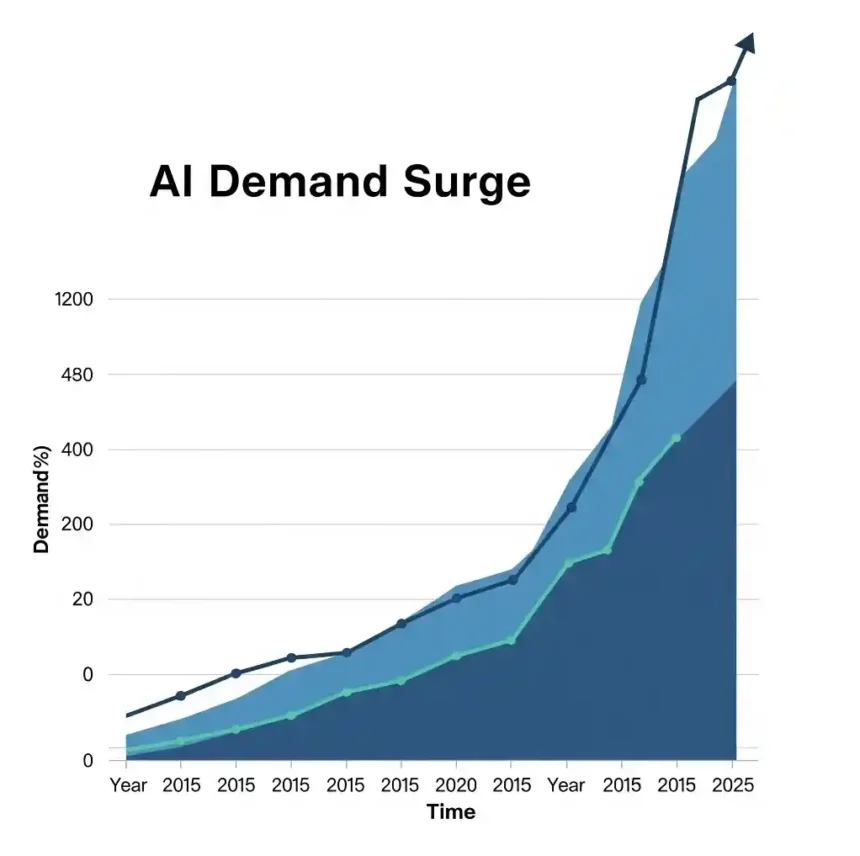ASML Holding NV, the global leader in photolithography equipment for semiconductor manufacturing, delivered a stellar performance in its Q2 2025 earnings, propelled by booming demand for AI-driven chips. Released on July 16, 2025, the Dutch company’s results surpassed market expectations, with robust order bookings signaling a promising trajectory for 2026. This article explores ASML’s financial achievements, the pivotal role of AI investment, geopolitical challenges, and the company’s strategic positioning in the rapidly growing semiconductor market.
Q2 2025 Financial Performance: Exceeding Expectations
ASML’s Q2 2025 earnings underscored its dominance in the semiconductor equipment market. The company reported net sales of €7.69 billion, slightly above the consensus estimate of €7.51 billion. Net bookings reached an impressive €5.54 billion, exceeding analyst forecasts of €4.8 billion, with €2.3 billion attributed to extreme ultraviolet (EUV) lithography systems. These systems are vital for producing advanced chips used in AI, high-performance computing, and memory applications. ASML’s gross margin climbed to 53.7%, surpassing expectations of 51.9%, driven by a favorable product mix and operational efficiencies. Earnings per share were €5.90, closely aligning with market projections.
A significant milestone was the shipment of ASML’s first EXE:5200B system, a next-generation EUV tool designed to enhance chip manufacturing precision. The Logic segment, encompassing chips for AI and computing, accounted for 69% of system sales, while the Memory segment contributed 31%. Geographically, Taiwan led with 35% of system sales, followed by China at 27%, South Korea at 19%, and the United States at 10%. This diversified customer base highlights ASML’s global reach and ability to serve varied markets.
Despite the strong results, ASML’s shares experienced a slight dip of 0.21% to €821.28 in premarket trading, following a 2.02% gain in the prior session. This decline likely reflects investor caution due to the company’s conservative Q3 guidance, projecting net sales of €7.4 billion to €7.9 billion, below the consensus of €8.21 billion, with a gross margin of 50% to 52%. The cautious outlook stems from order pushouts and softer demand in certain market segments, particularly memory.
AI Investment as a Growth Catalyst
The semiconductor industry is undergoing a structural transformation, fueled by the rapid rise of artificial intelligence. ASML, as the sole supplier of EUV lithography systems, is at the forefront of this shift. Major technology companies, including Meta, Google, Amazon, and Microsoft, are allocating substantial budgets to AI infrastructure, with combined capital expenditure for 2025 estimated at $392 billion, of which 44% is dedicated to AI-related projects. This surge in investment is driving demand for advanced chips produced at 3nm and 2nm nodes, which rely heavily on ASML’s EUV technology.
Taiwan Semiconductor Manufacturing Company (TSMC), ASML’s largest customer, is a key beneficiary of this trend. TSMC has committed $42 billion to expand its capacity in 2025, focusing on 2nm chip production to meet the needs of AI chipmakers like NVIDIA. ASML’s CEO, Christophe Fouquet, highlighted AI as the primary growth driver, noting, “The semiconductor market is robust, with AI spurring demand but also reshaping market dynamics.” The €5.54 billion in Q2 bookings, particularly in the Logic segment, reflects this momentum, as chipmakers gear up for advanced node production in 2026 and 2027.
However, not all segments are thriving equally. While foundries like TSMC are experiencing strong demand, some memory market players are grappling with slower recovery. This uneven performance contributes to a mixed outlook, with ASML navigating a complex landscape of customer needs and market cycles.
2026 Outlook: Order Bookings Signal Strength
ASML’s 2026 growth prospects are closely tied to its order bookings, which serve as a leading indicator of future revenue due to the 12- to 18-month lead times for its lithography systems. The €5.54 billion in Q2 bookings provides confidence that ASML is on track to achieve its 2025 revenue guidance of €30 billion to €35 billion, representing approximately 15% growth from 2024’s €28.3 billion. At its November 2024 Investor Day, ASML outlined an ambitious long-term vision, projecting annual revenue of €44 billion to €60 billion by 2030, with gross margins of 56% to 60%.
This optimism is driven by expectations that the global semiconductor market will exceed $1 trillion by 2030, with AI chips accounting for 40% of the total. ASML’s monopoly on EUV systems positions it to capture a significant share of this growth. However, challenges persist. Some orders originally scheduled for 2025 have been deferred to 2026 due to delays in customer fab construction, influenced by slower demand recovery and competitive pressures in the logic market. Barclays analyst Simon Coles noted that ASML would need to sustain strong booking momentum to meet 2026 revenue targets comfortably, emphasizing the importance of Q2’s performance as a bellwether.
Navigating Geopolitical and Market Risks
ASML operates in a complex geopolitical environment, with U.S.-China trade tensions posing a significant challenge. In 2024, China accounted for 41% of ASML’s revenue, but tightened U.S. export controls are expected to reduce this to around 20% in 2025. Despite these restrictions, Chinese chipmakers continue to drive demand for ASML’s deep ultraviolet (DUV) systems, which are not subject to export bans, contributing 27% of Q2 system sales. CFO Roger Dassen emphasized that current export controls are already factored into the company’s 2025 guidance, but further restrictions could introduce additional risks.
Tariffs also present uncertainty. ASML flagged potential margin pressure due to U.S. tariff announcements, reflected in its conservative Q3 gross margin guidance of 50% to 52%. However, the company’s diversified revenue streams, including high-margin services from its installed base of over 500 tools worldwide, provide a buffer against these challenges. The installed base business, which includes service and upgrade revenues, grew 38% year-over-year in Q4 2024 and remains a stable contributor to ASML’s financial health.
Strategic Strengths and Long-Term Potential
ASML’s unmatched position in EUV lithography underpins its long-term growth potential. The company’s investments in research and development, despite pressures from wage inflation, ensure it remains a leader in semiconductor innovation. The shipment of the EXE:5200B system and the deployment of High-NA EUV systems to three customers in Q1 2025 demonstrate its commitment to pushing technological boundaries. These advancements enable chipmakers to produce smaller, more powerful chips, meeting the demands of AI and other high-performance applications.
ASML’s financial discipline further enhances its appeal to investors. In Q1 2025, the company repurchased €2.7 billion worth of shares, signaling confidence in its cash flow generation. Additionally, ASML plans to increase its 2024 dividend by 4.9% to €6.40 per share, reinforcing its commitment to shareholder value. These initiatives, combined with its diversified revenue streams and technological leadership, position ASML as a resilient player in the semiconductor industry.
ASML’s Role in the Semiconductor Future
ASML’s Q2 2025 earnings highlight its critical role in the AI-driven semiconductor boom. The €5.54 billion in bookings, surpassing expectations, reflects robust demand for EUV systems, particularly from foundries like TSMC preparing for 2nm production. While geopolitical risks and tariff uncertainties pose challenges, ASML’s diversified customer base, innovative product portfolio, and stable service revenues provide resilience. The company’s 2026 outlook remains strong, supported by a projected $1 trillion semiconductor market by 2030, with AI as the primary growth engine.
Investors should closely monitor ASML’s order bookings in the coming quarters, as they will be a key indicator of its ability to meet 2026 targets. Despite short-term market volatility, ASML’s unique position in the semiconductor supply chain makes it a compelling long-term investment. As the industry evolves, ASML’s ability to navigate market dynamics and capitalize on AI demand will shape its future, but its Q2 performance suggests it is well-prepared to lead the charge.






Attractive section of content. I just stumbled upon your site and in accession capital to assert that I get in fact enjoyed
account your blog posts. Anyway I will be subscribing to your feeds and even I
achievement you access consistently rapidly.